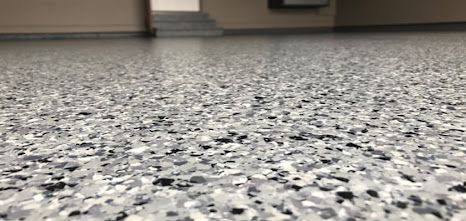Concrete Polishing Concepts
Diamond polishing of concrete as a finished product is a relatively recent concept in construction industry. It 15-20 years old! In Eastern Ontario the concrete polishing ideas came to practicing only 5 years ago...
Polishing is suitable for refurbishing old acid staining raleigh concrete flooring or producing new durable, low-maintenance, high gloss installations. This process provides cost-effective flooring option that can accommodate tight budgets and creative design.
So, why is it so popular and how does the process work?
Walk-behind concrete machines with rotating diamond-abrasive heads remove the surface layer of the concrete and achieve a fine polish. Progressively finer diamond-abrasive segments are used, starting with very coarse grinding abrasives that remove thickness quickly, and moving to metal-bonded diamond heads. From there, resin-bonded diamonds achieve various degrees of polishing up to highly reflective sheen. At some point in the grinding process, sodium silicate (or a related siliconate) is applied to the floor to densify, or harden, the concrete. The solution is absorbed into the concrete matrix, filling the pores. Chemically, the silicate reacts with the calcium hydroxide in the concrete to produce calcium silicate hydrate. Potassium silicate, lithium silicate, and various siliconates are also used in other proprietary formulations. After the silicate infuses into the concrete, it crystallizes in place.
Then the polishing continues. Color of various shade can me impregnated into the surface providing vibrant and unique translucent tones.
Then final concrete enhancement is applied to the surface. Hybrid inorganic / organic Nano lithium surface treatments are the latest trend nowadays. Concrete enhancers additionally seal concrete floors, producing a very hard, dust repellent, chemical resistant and water tight surface.
The process of concrete polishing is carried out in technically advanced "water-free" and "dust-free" environment where any airborne dust is collected by dust extractors eliminating up to 99.96% dust of 0.3 microns.
Follow to architectural specification the concrete surface can be colored with solvent based translucent penetrating dye concentrates, water-based stains or acid stains creating a range of piece of arts from subtle earth tones to vivid hues.

.jpg)
.jpg)
.jpg)
Comments
Post a Comment